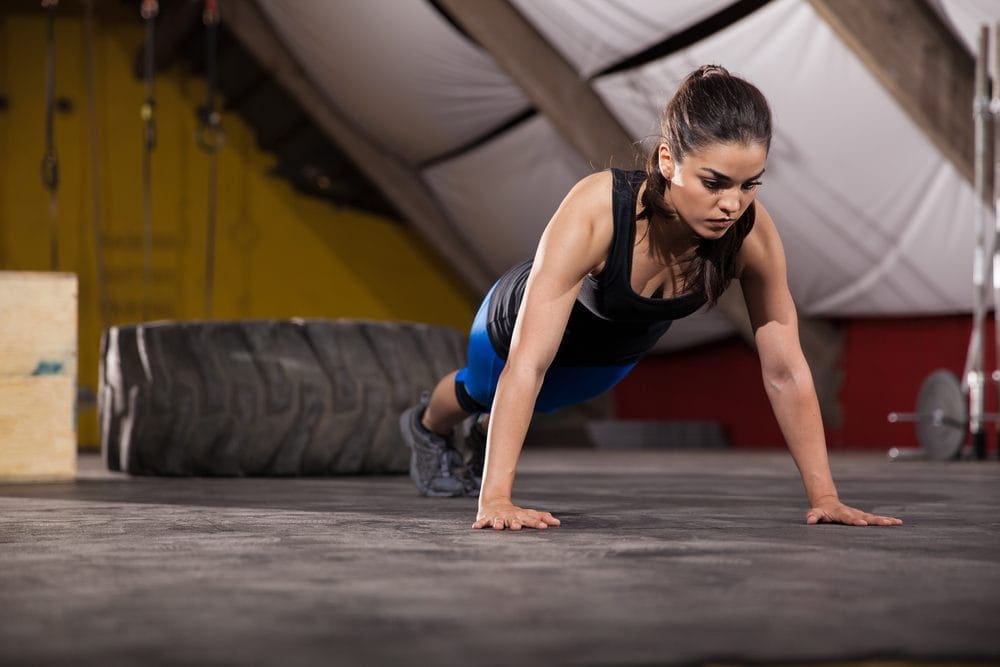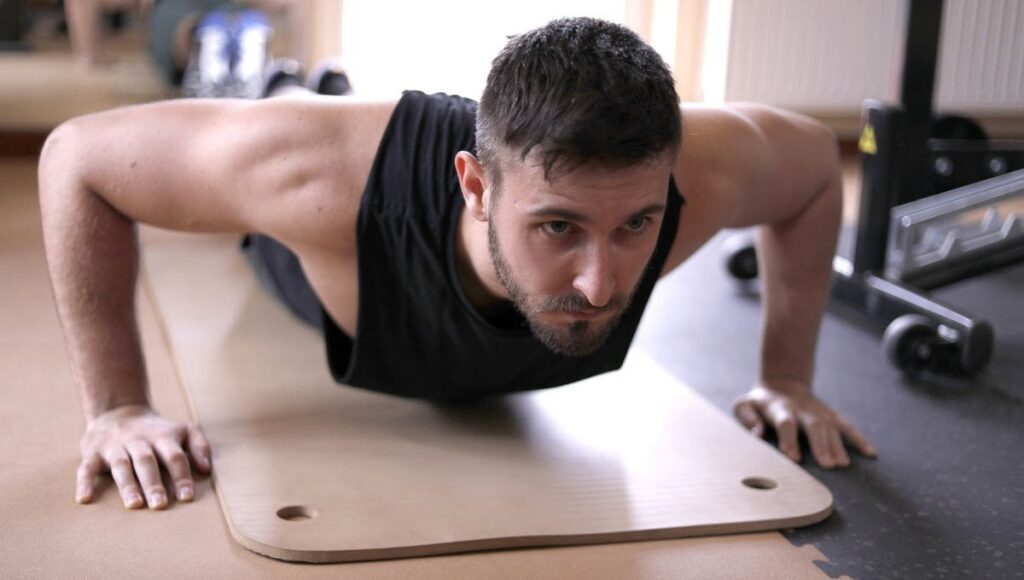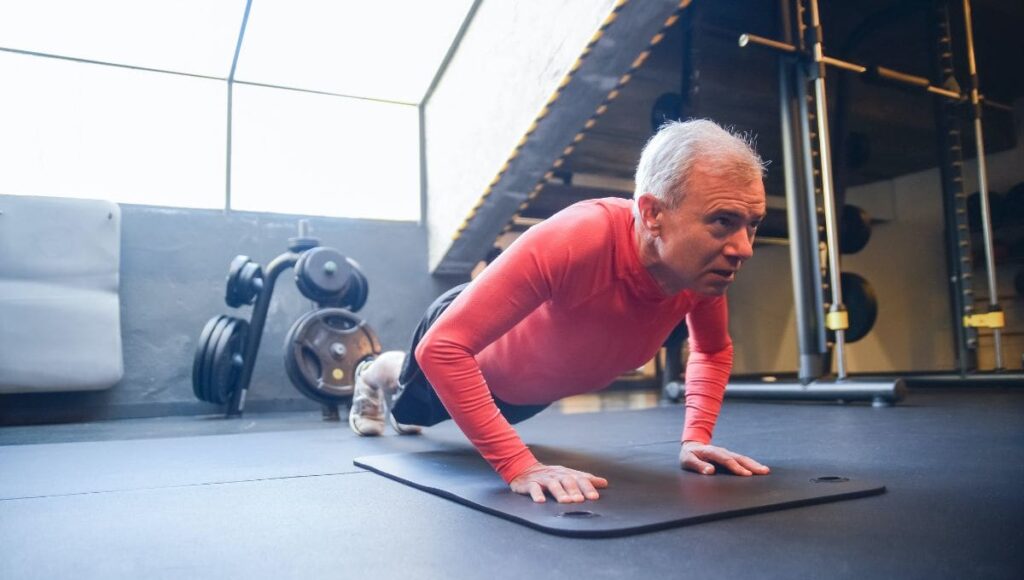Learn how to unlock your push up strength in only 5 minutes! The information below was extracted from Jeremy Ethier’s expertise. He is a kinesiologist and fitness trainer, co-founder of Built With Science. His YouTube channel has over 4 million subscribers and he delivers clear information with sound background research.
The push-up. One of the best bodyweight exercises a person can do. Honestly, there are incredible benefits to doing them regularly that it is a wonder that more people are not cranking them up any chance they get.
- Full-Body Exercise: Push-ups engage multiple muscle groups, making them a compound exercise that works various areas of the body simultaneously. They primarily target the chest muscles (pectoralis major), shoulders (deltoids), and triceps, but also engage the core, back, and leg muscles to stabilize the body during the movement.
- Strength and Muscle Development: Push-ups are an effective bodyweight exercise for building upper body strength and muscle. They target the muscles mentioned above and can lead to increased muscle mass, especially in the chest, shoulders, and triceps. Consistently performing push-ups with proper form and gradually increasing the intensity can help promote muscular development and overall strength.
- Functional Fitness: Push-ups mimic movements that are fundamental to daily activities, such as pushing objects, getting up from the ground, or performing tasks that require upper body strength. By regularly incorporating push-ups into your workout routine, you can enhance your functional fitness and improve your ability to perform daily tasks efficiently.
- Core Stabilization: Push-ups engage the core muscles, including the abdominal muscles and lower back, to maintain stability throughout the exercise. This helps strengthen the core and improves overall stability, which can enhance posture, balance, and overall athleticism.
- Versatility and Accessibility: Push-ups can be performed almost anywhere without the need for equipment, making them a versatile and accessible exercise. Whether at home, outdoors, or in a gym, you can include push-ups in your workout routine with ease.
- Scalability and Progression: Push-ups can be modified to suit different fitness levels. If you’re a beginner, you can start with modified push-up variations, such as knee push-ups or inclined push-ups against a raised surface. As you build strength, you can progress to standard push-ups and even advanced variations like decline push-ups or plyometric push-ups. This scalability allows individuals to continually challenge themselves and progress over time.
- Cardiovascular and Metabolic Benefits: Push-ups, when performed at a higher intensity or as part of a circuit training routine, can elevate your heart rate, providing cardiovascular benefits and contributing to calorie burning and metabolic improvements.
If you don’t know how to perform a single push-up yet, click on the link below.
Push-Up 101: The Only Guide You Need

But chances are, if you clicked here, that you know how to do push-ups. The difficulty actually is doing more, getting stronger by cranking up more reps.
See below what Jeremy Ethier had to say about how to unlock your push-up strength in only 5 minutes.
How To Unlock Your Push-Up Strength in Only 5 Minutes
First thing you should be conscious about is your setup. To improve your push-up strength and form, you would want your elbows to make an “arrow” shape, not a “T” shape with elbows flaring out. This is roughly a 45 to 60-degree angle from your torso.
Most likely, you will end up with a hand placement at the mid-chest level and with a width just outside the shoulders.
Next, you need to activate a couple of muscles to stabilise your body as you perform the push-ups. Push your knuckle down into the floor and spread your hands so that there is space between each of your fingers – this will help incorporate more of your chest muscles. Slide your shoulders down and away from your ears to turn on your lats. Don’t forget to pull your chin back to draw your head back in line with your body to avoid stressing the neck.

Your upper body now should be stabilised and now we move to the lower body portion. Tuck in your tailbone, take a breath in, engage your core, and dig your toes into the floor while squeezing your thigh really tight to fully extend your leg.
A great to start the push-up is by beginning with the pulling part, not the pushing-up. From the top position, use your back muscles to pull yourself to the floor instead of letting gravity do its bid as if you were performing rows. Keep your elbows directly over the wrists.
While squeezing your butt and thighs, push away from the floor to the top to open up your shoulder blades again, like in the setup. Hips, head and feet should make one straight line when you reach the top.
See the video below for a full explanation from Ethier himself.
9 Habits Killing Your Testosterone Levels
How to Speed Up Weight Loss – 10 Things You Can Do Now to Accomplish That
12 Must-Have Exercises In Your Training Program
Push-ups can be incorporated into your workout in a variety of ways, depending on your fitness level and goals. Here are some suggestions:
- As a warm-up: Start your workout with a set of push-ups to warm up your upper body and activate the muscles you’ll be using during your workout.
- In a circuit: Include push-ups as part of a circuit training workout, where you perform a series of exercises back-to-back with little to no rest in between.
- As a standalone exercise: You can do push-ups as a standalone exercise, either for a specific number of reps or for a certain amount of time.
- With variations: Add variety to your push-up routine by incorporating different variations, such as incline push-ups, decline push-ups, diamond push-ups, or plyometric push-ups.
- Superset with other exercises: Pair push-ups with other exercises that work different muscle groups, such as squats or lunges, to create a full-body workout.
- With increasing difficulty: Challenge yourself by increasing the difficulty of your push-ups over time, such as by adding weight, decreasing the rest time between sets, or increasing the number of reps.
Remember to always maintain proper form during your push-ups to avoid injury and maximize the effectiveness of the exercise.
 Source: Kampus Production on Pexels
Source: Kampus Production on PexelsDifferences Between Training for Size and Training for Strength
The Best Exercise You’re Not Doing (But Should)
8 Gym Machines You Should Stop Using
8 Important Yet Neglected Muscles and How to Strengthen Them
Image Sources
- Elder push-up: Kampus Production on Pexels
- athlete perfroms push-ups: Ketut Subiyanto on Pexels
